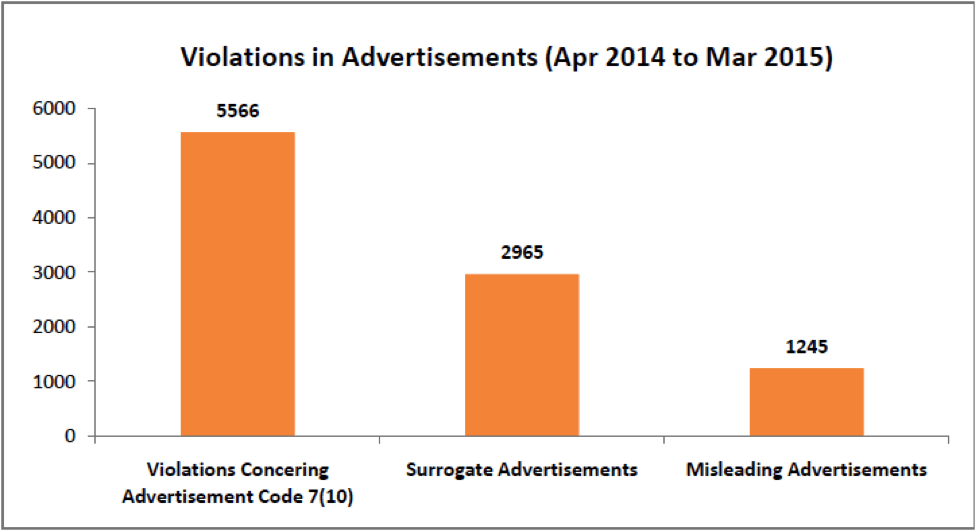[orc]A recent order by the Central Information Commission forced the Electronic Media Monitoring Centre (EMMC) to voluntarily disclose violations of various laws by satellite TV Channels. Prior to this order, the existence of such an entity was unknown to a lot of people. Post that order, the EMMC put the list of violations by TV Channels on its website. These violations of various acts run into thousands for just one year (2014-15).
Electronic Media Monitoring Centre (EMMC) was established in 2008 as a sub-ordinate office under Ministry of Information & Broadcasting with the exclusive task of monitoring content of private satellite TV channels for violations of Programme Code and Advertising Code. At present, EMMC records and monitors around 300 TV channels. EMMC monitors and carries out a scrutiny of violations by electronic media in accordance with Codes framed under the Cable Television Networks Regulation Act, 1995. EMMC puts out reports on violations along with the recorded clips to the Scrutiny Committee, which examines and goes into the purported violations and forwards its findings to the Inter-Ministerial Committee and other bodies for further action.
However, EMMC had been ‘carefully’ hiding from public scrutiny, even basic information regarding thousands of violations by various TV channels. Not many know that such an organization even exists.
‘Media Watch-India’, a nonprofit campaigning for decency and accountability in Media made a request under RTI act in 2012 to disclose and publish the details of violations by various private TV channels on EMMC website in terms of section 4 of RTI act. However, Director, EMMC squarely rejected the plea without citing any reason.
Based on a complaint by ‘Media Watch-India’ (MWI), Central Information Commission (CIC) directed Electronic Media Monitoring Centre (EMMC) to publish the details of violations of Programme and Advertising Codes by private TV channels. EMMC implemented this order few days back which revealed mind-blowing numbers of content violations by TV channels.
Pursuant to this order, EMMC now published statistics of violations on its website which are available here.
Statistics Revealed by EMMC are startling
EMMC put up statistics related to the year 2014-15 on its website. The violations of television channels on various counts run into thousands.
Violations Regarding Films and Promos
Hundreds of violations were reported each month with respect to screening of films, for example, non-display of Censor certificate before screening of films, non-indication of Censor rating as part of film promos which are otherwise cognizable and non-bailable offences under section 7(1) of the Cinematograph Act, 1952.
A total of 8487 violations were reported in this category for the year 2014-15. Highest number of violations was in June 2014 (939) and the lowest in December 2014 (261).
Category Wise Violations (April 2014 to November 2014)
Violations on account of ‘vulgarity/obscenity’ and ‘excessive violence’ top in the category-wise analysis of violations.
Violations in Advertisements (April 2014 to March 2015)
As far as violations regarding advertisements are concerned, during the financial year 2014-15 alone,
- A whopping number of 5566 violations were reported of rule 7(10) of Cable Networks Rules, 1994. These relate to the distracting ‘part-screen’ and ‘scrolling’ ads interfering with the programme and ‘paid promotional programmes’ telecast under the garb of news
Rule 7(10) of the said rules read thus:
“All advertisement should be clearly distinguishable from the programme and should not in any manner interfere with the programme viz., use of lower part of screen to carry captions, static or moving alongside the programme.“
- 2965 instances of surrogate advisements of liquor/tobacco products were reported in the same period.
- 1245 instances of misleading advertisements were reported, i.e., superstitious and deceptive ads of kavachas, yantras, medicines, creams etc. claiming to posses miraculous powers which are otherwise serious offences under Drugs and Magic Remedies (Objectionable Advertisements) Act, 1955.
While these numbers are based on random monitoring of about 1/3rd of total channels in the country, one can imagine the actual number of violations by all channels in the country.
Edara Gopi Chand, Vice-President of MWI said: “This is a big leap forward in enhancing transparency and accountability in the otherwise ‘hidden’ regime of broadcast regulation in India. However, it is only a partial success. Mere publishing of statistical figures is meaningless unless the names of the violating channels and nature/gravity of each violation are revealed.
The next big question that arises is what the Government is doing about these violations. It is an open secret that the Ministry of I&B is simply sitting on the reports without any action. It is giving occasional ‘advisories’ to which no channel pays heed. In rarest of the rare cases, when the penal powers are enforced, i.e., prohibiting telecast of the offending channel for few days, the broadcasters are running to High Courts crying ‘government regulation’ of media.”
He further added, “Airwaves are ’public property’ as held by the Apex Court. As such, the Public have the basic right to know how and by which entities such ‘airwaves’ are being misused. EMMC’s deliberate refusal to disclose details of violations so far has to be seen in the context of overall scheme of ‘media-appeasing’ tactics and ‘don’t-care-for-the-audience’ attitude of successive governments.”
Source:
- Data from EMMC




